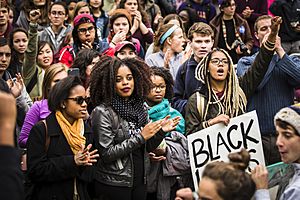Intersectionality facts for kids
Intersectionality is a way of understanding how different parts of a person's identity can lead to them being treated unfairly. It looks at how things like race, gender, and class can combine. Kimberlé Williams Crenshaw first used the word "intersectionality" in 1989.
Sometimes, a society treats certain groups of people as "different" or "outsiders." This is called marginalizing them. Intersectionality shows that people can be marginalized for many reasons at once. These reasons might include their gender, race, class, ability, sexual orientation, religion, age, or nationality.
Because of this, these different types of unfair treatment cannot be looked at separately. They must be seen together. For example, a person might face unfair treatment because they are a woman, a person of color, and a disabled person all at the same time. These different forms of unfair treatment can make each other worse. They shape each other and support each other. This means that the experience of being treated unfairly for all these reasons is unique. It is different from just adding up each problem alone. So, fighting each problem by itself might not fully help people who experience many of them at once.
Intersectionality says that the different ways people are treated unfairly create a whole system. In this system, each type of unfair treatment contributes to the others. For example, racism, sexism, classism, and ableism are all connected. If someone wanted to understand how a society began to treat a group of people as a separate race, they would also need to look at how gender, class, and other parts of identity played a role.
Contents
How Intersectionality Started
Intersectionality began as a way to understand how women of color in American society faced unfair treatment. The women who developed this idea were challenging the feminism of their time. They felt that this feminism focused too much on the issues of wealthy white women. They believed this left behind the women who needed feminism the most. It only seemed to help women who already had more power.
They also criticized the Civil Rights Movement. They saw it as focusing too much on men. They felt it left women of color behind. These women believed they had a place in both of these movements. They felt that these parts of their lives could not be separated. Intersectional theory quickly grew. It began to include the connections between all the many ways people are treated unfairly.
Why Intersectionality Matters
Understanding Different Experiences
Intersectionality helps us understand that not everyone experiences the world in the same way. For example, a Black woman might face challenges that are different from those faced by a white woman or a Black man. Her experiences are shaped by both her race and her gender at the same time.
Working Towards Fairness
By understanding intersectionality, we can work better to make society fairer for everyone. It shows us that we need to consider all the different ways people can be treated unfairly. This helps us create solutions that truly help those who are most affected. It encourages us to look at the bigger picture of how different types of unfairness are linked.
See also
 In Spanish: Interseccionalidad para niños
In Spanish: Interseccionalidad para niños


